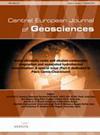REE mineralization in the carbonatites of the sung valley ultramafic-alkaline-carbonatite complex, Meghalaya, India
引用次数: 20
Abstract
The Early Cretaceous Sung Valley Ultramafic-Alkaline-Carbonatite (SUAC) complex intruded the Proterozoic Shillong Group of rocks and located in the East Khasi Hills and West Jaintia Hills districts of Meghalaya. The SUAC complex is a bowl-shaped depression covering an area of about 26 km2 and is comprised serpentinised peridotite forming the core of the complex with pyroxenite rim. Alkaline rocks are dominantly ijolite and nepheline syenite, occur as ring-shaped bodies as well as dykes. Carbonatites are, the youngest intrusive phase in the complex, where they form oval-shaped bodies, small dykes and veins. During the course of large scale mapping in parts of the Sung Valley complex, eleven carbonatite bodies were delineated. These isolated carbonatite bodies have a general NW-SE and E-W trend and vary from 20–125 m long and 10–40 m wide. Calcite carbonatite is the dominant variety and comprises minor dolomite and apatite and accessory olivine, magnetite, pyrochlore and phlogopite. The REE-bearing minerals identified in the Sung Valley carbonatites are bastnäsite-(Ce), ancylite-(Ce), belovite-(Ce), britholite-(Ce) and pyrochlore that are associated with calcite and apatite. The presence of REE carbonates and phosphates associated with REE-Nb bearing pyrochlore enhances the economic potential of the Sung Valley carbonatites. Trace-element geochemistry also reveals an enrichment of LREEs in the carbonatites and average ΣREE value of 0.102% in 26 bed rock samples. Channel samples shows average ΣREE values of 0.103 wt%. Moreover, few samples from carbonatite bodies has indicated relatively higher values for Sn, Hf, Ta and U. Since the present study focuses surface evaluation of REE, therefore, detailed subsurface exploration will be of immense help to determine the REE and other associated mineralization of the Sung Valley carbonatite prospect.印度梅加拉亚邦宋谷超镁铁质-碱性-碳酸盐岩杂岩碳酸岩中的稀土矿化
早白垩世嵩谷超镁铁碱碳酸岩杂岩侵入元古界西隆群,位于梅加拉亚邦东卡西山和西耆那亚山。SUAC杂岩体是一个碗状凹陷,面积约26平方公里,由蛇纹橄榄岩组成,形成杂岩体的核心,边缘为辉石岩。碱性岩以橄榄岩和霞石正长岩为主,呈环状体和脉状。碳酸盐岩是杂岩中最年轻的侵入阶段,形成椭圆形体、小脉脉。在宋谷杂岩部分地区的大比例尺填图过程中,圈定了11个碳酸盐岩体。这些孤立的碳酸盐岩体总体呈北西-东西和东西走向,长20 ~ 125 m,宽10 ~ 40 m。方解石碳酸盐是主要品种,由少量白云石和磷灰石组成,辅之有橄榄石、磁铁矿、焦绿石和绿云母。在嵩谷碳酸盐岩中发现的含稀土矿物有bastnäsite-(Ce)、绿铅石-(Ce)、绿铅石-(Ce)、绿铅石-(Ce)、辉绿石-(Ce)和与方解石、磷灰石伴生的辉绿石。与含REE- nb焦绿石伴生的稀土碳酸盐和磷酸盐的存在,增强了嵩谷碳酸盐的经济潜力。微量元素地球化学结果显示,26个床岩样品中碳酸盐岩中lree富集,平均ΣREE值为0.102%。通道样本显示平均ΣREE值为0.103 wt%。此外,少数碳酸盐岩样品中Sn、Hf、Ta和u的值相对较高,由于本研究侧重于地表稀土元素的评价,因此,详细的地下勘探将对确定嵩谷碳酸盐岩远景区稀土元素及其他伴生成矿作用有很大帮助。
本文章由计算机程序翻译,如有差异,请以英文原文为准。
求助全文
约1分钟内获得全文
求助全文
来源期刊

Central European Journal of Geosciences
GEOSCIENCES, MULTIDISCIPLINARY-
自引率
0.00%
发文量
0
审稿时长
>12 weeks
 求助内容:
求助内容: 应助结果提醒方式:
应助结果提醒方式:


